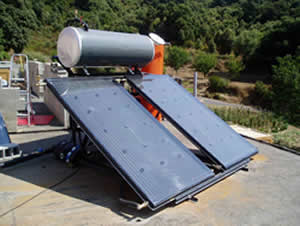solar collector

Efficiency graph of solar collector performance.

Graph of efficiency and temperature
ranges of various types of collectors
(radiation: 1000 W/m2).
A solar collector is a device used to collect, absorb, and transfer solar energy to a working fluid, such as water or air. The solar heat can be used for heating water, to back up heating systems, or for heating swimming pools.The heart of a solar collector is the absorber, which is usually composed of several narrow metal strips. The carrier fluid for heat transfer flows through a heat-carrying pipe, which is connected to the absorber strip. In flate-plate absorbers, two sheets are sandwiched together allowing the medium to flow between the two sheets.
 |
Types of solar collector include:
- Back-pass collectors
- Parabolic dish collectors
- Parabolic trough
collectors
- Power towers
- Stationary
concentrating collectors
How much energy does a solar collector provide?
The efficiency of a solar collector is defined as the quotient of usable thermal energy versus received solar energy. Besides thermal loss there alwas is optical loss as well. The conversion factor or optical efficiency h0 indicates the percentage of the solar rays penetrating the transparent cover of the collector (transmission) and the percentage being absorbed. Basically, it is the product of the rate of transmission of the cover and the absorption rate of the absorber.
The heat loss is indicated by the thermal loss factor or k-value. This is given in watt per m2 collector surface and the particular temperature difference (in °C) between the absorber and its surroundings. The higher the temperature difference, the more heat is lost. Above a specific temperature difference, the amount of heat loss equals the energy yield of the collector, so that no energy at all is delivered to the solar circulation system. A good collector will have a high conversion factor and a low k-value.
| Type of collector | Conversion factor | Thermal loss factor (W/m2 °C) | Temp. range (°C) |
| uncovered absorber | 0.82 - 0.97 | 10 - 30 | up to 40 |
| flat-plate | 0.66 - 0.83 | 2.9 - 5.3 | 20 - 80 |
| evacuated-plate | 0.81 - 0.83 | 2.6 - 4.3 | 20 -120 |
| evacuated-tube | 0.62 - 0.84 | 0.7 - 2.0 | 50 - 120 |
| reservoir collector | about 0.55 | about 2.4 | 20 - 70 |
| air collector | 0.75 - 0.90 | 8 - 30 | 20 - 50 |
Which collector is suitable for which situation?
The desired temperature range of the material to be heated is the most important factor in choosing the correct type of collector. An uncovered absorber is certainly not suitable for producing process heat. The amount of radiation on that spot, exposure to storms, and the amount of space must all be carefully considered when planning a solar array.
The specific costs of collectors are also important. Evacuated-tube collectors are substantially more expensive than flat-plate collectors or even plastic absorbers. However, a good collector does not guarantee a good solar system. Rather, all components should be of high quality and similar capacity and strength.
